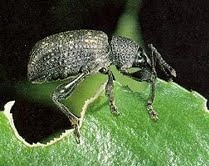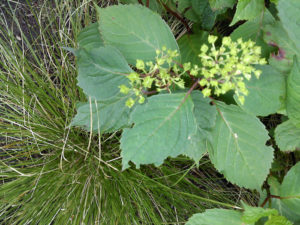Why you should care about root weevils, and what to do about them once you do.

Many Portland established shade gardens have leaf damage from adult root weevils (see photo showing leaf notching). It is ugly, but it doesn’t kill your plant. A lot of leaf notching can spoil the looks of the plant just when you wanted to enjoy its beauty. The serious problem is caused by their larvae who eat the roots of your plants during the late fall and winter. It is very difficult to kill the larvae because they live underground nestled into the roots of your plants to be close to their chosen food source. Think of them as tiny, tiny zombies! Rooooooooooooooootttttssssssssssssss………..
So how do you know if you have a root weevil problem? Here is what I recommend:

It’s the damage done to the roots that we worry about. We must control the adult weevil before she lays her eggs.
Check your indicator shrubs for notching! These are Hydrangea, Red Twig Dogwood, Azalea, and Rhododendrons. Many perennials will also show the notched leaves such as Hostas and Coral Bells (Heuchera). If you have only a few notches, you don’t have to do anything or you could treat once a year as a preventative measure. If you have more than a few notches, we need to talk but you can also check out my other root weevil blog for all the gory details of killing root weevils. It is tricky to do.
Don’t bring them into your garden………Here is a timely tip, be very picky about buying plants on discount, or at fundraisers! Look for notching on the leaves, and don’t buy any plant that has notching, or is near plants with notching. Root weevil can walk over to the plants near by and lay eggs so even if there is no notching on a plant there are probably eggs in the potting soil. You don’t want to introduce them into your garden. (I’m not saying they came from your freshly purchased potting soil….root weevil just walk from one plant to another and lay their eggs.)
Now the important part. How do you get rid of them? Hand picking is the easiest to actually do but they can be very hard to spot. This dull colored beetle is only 1/4″ and hides effectively in the top of the soil or inside a leaf crevice. It can take checking your plants several evenings a week with a flashlight to find even one.
The chemical products out there are harmful to you and the bees which we need in order to have food. Using chemicals to get rid of root weevils is definitively not the way to go.
I purchase living nematodes that are specifically listed for root weevil. Properly applied, they will swim through your soil, enter the body of the root weevil larvae, and lay their eggs. The nematode hatchlings will eat the larvae. Initially you will do this in both September /early October and the following May which are the ideal nematode vs. larvae times!
The 3 most important things:
The soil must be warmed up and moist
You must apply the nematodes at dusk, never in direct sunlight.
Get the timing right-treat in May or early June. Treat again in September. If we are having a cool May you may want to wait until June. In September you want to be sure your soil is well watered prior to the treatment of nematodes, and then water well for two weeks following the treatment. This will eliminate some of the root weevil problem for the next year. You will have to repeat the biannual treatments for a few years to get the weevils properly controlled, and then continue with a once a year preventative treatment cycle (in September).
You’ll get better results if you use Pondzyme in the water before you add the nematodes.
The good news is that it is really easy to do…ok it’s tedious but your shade garden can look so bad if root weevils become numerous.
1) Take a 5 gallon bucket and fill it up with water.
2) Treat the water with a product called pondzyme (people use it to protect their fish from the additives in our water). I use 1 and ¼ teaspoons of Pondzyme to 5 gallons of water.
3) Add the nematodes to the water.
4) Using a plastic pitcher, not metal, I then water the nematodes into the soil where I see leaf notching.
It is very little effort for a dramatic and healthy result. Good gardening!
Resources:
March Biological is mail order. I like them.
Living nematodes for root weevil larvae can often be purchased May through September at: Portland Nursery
http://www.portlandnursery.com/
Farmington Gardens
http://www.farmingtongardens.com/
Cornell Farms
http://www.cornellfarms.com/
and other higher end garden centers.
Tranquility Ponds has 3 locations and they sell an 8 oz bottle of Pondzyme for $26.00. Remember you need the pondzyme to protect your nematode warriors from chemicals in our water so don’t skip this step. It is very concentrated so it should last you a very long time. http://portlandpondsupplies.com/




